activity
ADACHI Tomomi activities
This page includes many Youtube links, also some low-quality video and MP3 links.
last updated 2014-11-11
Interpretations of Experimental Compositions
As a voice performer, director and organizer, I presented concerts focus on experimental compositions by other composers, especially works of John Cage, Christian Wolff and Cornelius Cardew in 1960s. Many of them were Japanese premiere and I worked as a theatrical director for some of them. My interests are: relationships between musical activities and politics / society (working with non-musicians), forms of notations for creative performances, fundamental ideas on live-electronic performance.
Performance with Voice and Original Physical Interfaces
These are trials to connect a sound processing techniques with a physical gesture that is accompanied with utterance. Gestures evoke voices, or opposite. In these pieces, the relationship is reconstructed with electronics, gestures work as a modulator for voice. All sounds are sampled in real-time without any pre-recorded sounds, Audience see all musical process clearly. These systems are used for not only solo performances but also improvisations with other performers.
Youtube
Voice and infrared Sensor Shirt (2004-)
Voice performance with infrared sensors on shirt. This is an instrument which is a shirt installed 10 infrared distance sensors. They are connected to computer, change voice following performer's body movements.
Voice and The Right Hand (2005-2006)
On right hand, there are 4 buttons and 2 dimensional tilt sensor. The computer analyzes voice sound and the position of the right hand, it changes many parameters of a modulation patch in real time.
Piano and Infrared Sensor Shirt (2007)
Piano version of “Infrared Sensor Shirt”.
Movie (mp4)
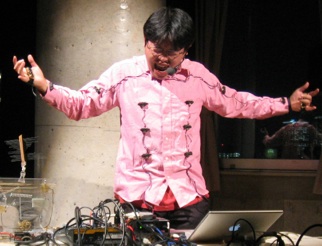
Sound Poetry
Sound poetry is considered as one of the root of my voice performance. I performed Kurt Schwitters's "Ursonate" as Japan premiere in 1996 and I am digging up little-known tradition of Japanese sound poetry as NIIKUNI Seiichi (1925-1977; the most important concrete poet in Japan) and Hide KINOSHITA (futurist painter, his trial in 1924 is the first published sound poetry in Japan,) also perform the works of living artists as NAKAZAWA Hideki (visual artist) and HAGA Toru (multi-disciplinary artist, his sound poetry has very calm and tender texture). Also visual poetry and conceptual writings are interpreted in voice performance. Some of my own sound poetry are based on meaningful texts with strict structures and/or gestures. Also the Cosmic Poem project was realized as the first sound art project in outer space.
In 2013, I organized Berlin Sound Poet Quoi Tête with other three Berlin-based Sound Poet; Ernesto Estrella, Jelle Meander and Cia Rinne as a group for collective sound poetry performance.
Selected repertoire (exclude my own works)
Kurt Schwitters: Ursonate, bii büll ree, Das Ganze husten
Hugo Ball: Gadji Beri Bimba, Seepferdchen und Flugfishche
Fortunato Depero: Canzone Futurista
Brion Gysin: I AM THAT I AM
Dick Higgins: Glasslass
The following part is a brief chronological table of Japanese sound poetry, appended original published years.
Hide KINOSHITA: Voice Sound Poetry Form Begun with -X- (1924)
MATSUZAWA Yutaka: Symbol Poem (1954)
SUZUKI Shirouyasu: Lyric Poetry Based on a Oral Muscle Sensation Theory (1959)
NIIKUNI Seiichi: Opus A, Opus Fu, For a Flower Position, The Second Hand, Opus Po, Opus Mi, Opus Wa, Opus Me, O.N.NA, Opus Ta, Opus KI, Opus 9, U.MU, MA.TSU.RI, KI.MO.NO, Opus a (1960-1963), Rain (1966), Cherry Blossoms and Camels (1968), Sea has already been reduced to pus (1971), Touch (1972), Exorcism (1974)
KAN-NO Seiko: from “SU-Shi” (1971)
HAGA Toru: Ki-Ka (1994)
NAKAZAWA Hideki: Japanese Syllabic Monophony (1999-2002)
MATSUI Shigeru: Sound Poetry: (2010)
Youtube
Voice Sound Poetry Form Ended With -X- from MAVOtek (with Jennifer Walshe)
This piece is taken from “MAVOtek” which is a project focuses on MAVO, Japanese Dada Group in 1920s. At Villa Elisabeth, Berlin 2012.
Berlin Sound Poets Quoi Tête, collective poetry performances
At Ausland, Berlin on Oct 23 2013
Berlin Sound Poets Quoi Tête, L'amiral cherche une maison à louer
A complete performance of simultaneous dada poem "L'amiral cherche une maison à louer" that was written by Richard Huelsenbeck, Marcel Janko, Tristan Tzara, Toshiro Sawa and premiered at Cabaret Voltaire in 1916. In this version, a forgotten Japanese part probably written by Japanese military attaché, Toshiro Sawa, is supplemented.
MP3 Audio - Sounds of Adachi’s Sound Poetry
"Anata 5" is from a series of poems using a humorous melodramatic phrase in Japanese as a starting point. The phrase is transformed systematically transforming into a different phrase.
"Schwitters Variations" (2001) 3.7mb
Variations on the theme of Kurt Schwitters's "Ursonate". It based 4 themes on 1st page of "Ursonate". They is transformed and reconstructed in the way as systematic repetition, backward, removing consonants, removing vowels and in a part, improvisations.
Link to other websites, many videos and sounds
Selected Interpretations
John Cage: Variations VII (performer, director), Europera 5 (director), Variations II (performer, director), Variations III (performer, director), Waterwalk (performer), Songbooks (performer, director), 62 Mesostics re Merce Cunningham (voice), Solo for Voice 2 (voice), Musicircus (director)
Christian Wolff: Burdocks (performer, director), Prose Collection (performer, director), Edges (performer)
Cornelius Cardew: Paragraph 4 & 7 from The Great Learning (performer, director), Treatise (performer)
Tom Johnson: Music & Questions (performer), 1 2 3 (conductor)
David Behrman: Wave Train (electronics)
TONE Yasunao: Clapping Piece (conductor)
ICHIYANAGI Toshi: Appearance (electronics), Sapporo (conductor), Pratyahara Event (performer, director)
Alvin Lucier: (.....) Memory Space (director, performer)
James Tenney: Postal Pieces (director, performer)
La Monte Young: 566 For Henry Flynt (piano, conductor)
The Fluxus Performance Workbook: works of George Brecht, Tomas Schmit, Dick Higgins, Milan Knizak, Genpei Akasegawa, Ben Vautier
Dieter Schnebel: Maulwerke (performer, director), Koerper-Sprache (performer, director), Visible Music I (performer)
TAKAHASHI Yuji: Irosesu (voice)
YUASA Joji: Calling together (voice), Kan-soku (voice)
Cathy Berberian: Stripsody (voice)
Youtube
Realization of huge live electronic piece written in 1966. Four performers mixed any kind of real-time sounds generated in the performance space and transmitted from all over the world by telephones, radios, internet and even psychics. More than 100 live sound sources were used include sounds from outer space, heart beats, brain waves, foot steps of audience. Many electric appliances were controlled by movements of performers and fishes in a tank. A mixing program was automated by wind directions of seven places around the world.
Cornelius Cardew The Great Learning Paragraph 4
An extract from 50 minutes long Japan premiere performance of "The Great Learning Paragraph 4" written by Cornelius Cardew. This concert "Plural Dimension of Music - Cornelius Cardew" included other Cardew's pieces "Treatise" (also as Japan premiere) and "The Great Learning Paragraph 7" performed by 38 musicians/non-musicians.
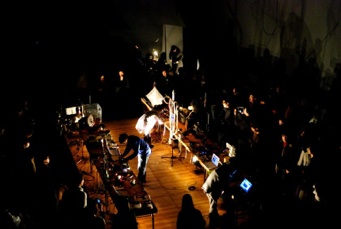
John Cage “Variations VII” at Asahi Art Square in 2011
photo Jun’ichi Ishizuka
Youtube
An Italian version of "Yumiko"(1997), originally written for "Adachi Tomomi Royal Chorus". A performance by members of Adachi's workshop in "mantica", a festival organized by an experimental theater company, Societas Raffaello Sanzio at Teatro Comandini, Cesena, Italy in Nov. 2008.
Performed by students of Department of Moving Images and Performing Arts, Tama Art University in Jan. 2009.
Performed by students of Yotsuya Art Studium, Tokyo in 2009.
Performed by performers from University of the Arts London at Tate Modern, London in 2010.
Performed by students of Department of Moving Images and Performing Arts, Tama Art University in Jan. 2008.
Performed by Adachi Tomomi Royal Chorus.
Score (jpg or pdf)
Namahage-mint (1999) for voices
Movie (low-quality QuickTime)
Other Musical Works
Youtube
Minna no Uta (Song for Everyone) (1995)
This performance is my early work for publicly gathered voice performers and 1 turntable player. The sounds from the turntable player are sent to 10 headphones which all performers put on their head. Performers just imitate and amplify the sounds to audience without any interpretations. But all performer's voices are different. Audience cannot hear original sounds.
This is a recording of the premiere at P3 Art and Environment (Yotsuya, Tokyo) in 1995. Turntable by TSUNODA Tsuguto.
Instrumental for Everyone (1995)
A derivative of Song for Everyone. Voice performers imitate sound of an instrument.
Electro-acoustic composition with video score for youtube listeners.
Scores and instruments are the same. A performance exhausts the scores/instruments.
Performance of piling coins. A self-made Theremin responds to the pile of coins (5 yen/brass) and actions of a performer.
Voice improvisation with hand claps by 5 volunteer performers from audiences. The hand claps responded to LED blinks of a Geiger Counter, means radiation detections. (Referential information; it was recorded at Koganei, Tokyo on March 19th 2011, in the second week of Fukushima I nuclear accident. Around 20 CPM was under the natural background level.)
Some old recordings by voice, electronics and self-made instruments.
MP3 Audio
Voice and Electronics Improvisation (2003) 1.9mb
Voice and Electronics Improvisation (2003) 2.6mb
Voice and Electronics Improvisation (2003) 5.1mb
Self-made Instrument and Electronics Improvisation (2003) 9.1mb

Installation
I have built some kinetic installations, sounds and images are generated in real-time with low-tech devices.
Also there is a series of site-specific loop-video installation consists of short recordings of physical performances.
Youtube
This is a kinetic video installation consists of the suspended three dusters with video cameras, electric motors and propellers. They spin and fly in unpredictable way, sometimes in unison. Audience sees their dance and the vision from them through three video monitors on the floor. The generated video image is a modulated environment that audiences exist.
Kinetic video/sound installation; two snail robots follow 2 same black line drawings on the floor. One snail has a wireless microphone. Another has a wireless camera. The radio on the side of a drawing receives the signal from microphone and also the TV monitor receives the signal from camera. As a result, radio makes a feedback sound melody follows the natural overtone and TV generates abstract video image. Sound and image are equivalent for the drawing. And 1 pig behaves sarcastically on the wall.
Movie (low-quality QuickTime)






Statement
My activities cover; improvisation, original physical interface for electronic music, self-made instrument, text-sound composition, sound/visual poetry, theatrical performance, mathematical composition, video and installation. Almost of them are related with music at least, but some of them don’t have any sounds. Also it is possible to say many aspects of my works are connected with poetry.
A large part of my works emphasizes visual elements of music (it doesn’t mean to add visual elements to music). I regard them as intermedia arts between music and dance, music and visual art, music and poetry. Sometimes even intermedia between poetry and visual art, poetry and dance.
Though I categorized my activities in the followings on this page, everything is connected and is a different aspect from one idea. Musical form or structure can be applied to non-musical materials.
Besides, as a performer/composer, I focus on tensions or oppositions between ideal concepts and physical presences. My starting point was Conceptual art and Minimal art in 1960s. I am trying to find another direction from them.
I believe that making art without systems of conventional technics is an important point for exploiting new perspective. Finally I focus on a relationship between autonomous art and society.

Improvisation
Improvisations with other musicians include Jaap Blonk, Nicolas Collins, Carl Stone, TAKAHASHI Yuji, SAKATA Akira, ICHIYANAGI Toshi, TANAKA Yumiko, dj sniff, Ute Wassermann, Richard Barrett, Annette Krebs, Jerome Noetinger, SUZUKI Akio, Alessandro Bosseti, FURUDATE Tetsuo, Jennifer Walshe, Dickson Dee, Zbigniew Karkowski, Johannes Bergmark, Erhart hirt, MAKIGAMI Koichi, OTOMO Yoshihide.
Youtube
Duo improvisation with Jennifer Walshe
At Theater die wohngemeinschaft, Cologne, 2012
Duo improvisation with dj sniff
At Superdeluxe, Tokyo 2008, “STEIM in Japan”
MP3 Audio
Duo improvisation with Annette Krebs
1. Recording at TU Electronic Music Studio, 2012 (21mb)
2. Short Excerpt from Live at Quiet Cue, 2013 (8mb)
Link to Soundcloud
PUTIF - telepathic improvisation project with Jennifer Walshe (2013)
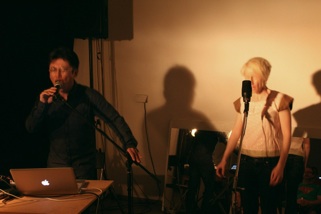
with Jennifer Walshe, 2012 photo Nicolas Wiese
Selected list of compositions and Youtube
It Is the Itchy Spot for piano, vibraphone, auxiliary performer(s) and video projection (2014)
commissioned by Tokyo Gen'On Project
This piece should be called "It Is Not the Itchy Spot" before the performance.
The score of this piece is written on a video as a kind of tablature.
commissioned by Tokyo Gen'On Project
Transcriptions of some fragments from assumed English translation of ancient Chinese music book, "Yue Jing" (Classic of Music.)
2013-10-14T06:49:10+02:00/2013-10-14T06:50:10+02:00 for five instruments (2014) commissioned by Tokyo Gen'On Project
A juxtaposition of different notation systems.
How to learn to talk 2U for Martin Riches' Talking Machine, Voice, Electronics and Gestures (2013)
commissioned by Hybrid Music
Composition for machine and human being.
Why you scratch me, not slap? Choreography for solo guitar player (2011) commissioned by YAMADA Gaku
An extremely unconventional notation is used. Movements of hands of guitar player are notated on a video. This notation is on a tradition of tab score.
Oscillating Heads for performers (2011)
Visual music.
Spatial Spatula, Spandrel for Piano and Voice with Objects (2011) commissioned by KUBOTA Midori
Canonic music for any kind of instruments.
Odorimbisha for Tokiwazu player, voice and live-electronics (2007) commissioned by Music From JAPAN
A reconstruction of Kabuki music and story. Premiered at Markin Concert Hall, New York
Brapandan for Piano (2006) commissioned by OOI Hiroaki
Monophonic canon.
Hereis a big collection of conceptual scores and pieces.

Site Specific Compositions
Some works were composed for particular sites or situations. These pieces are performed with huge numbers of local people, non-musicians and professional musicians. The composition process is based on rehearsals with musicians and a research of environment and social background. These compositions are mixtures of simple notation and improvisation.
List of compositions and Youtube
Spatial music for a fish-market. Composed for 10 tubas, orchestra, choir and cars, one conductor and three sub-conductors (total more than 70 musicians). Organized by Tokyo Culture Creation Project, Downtown Senju - Connecting Through Sound Art, and Tokyo Art Point Project.
For choir with vuvuzelas and bicycles, 4 trombones and 2 soloists. Composed for Tempelhof Airfield, Berlin, performed on 2012-8-18 as a part of "berlin sonic places" conceived by Peter Cusack. This piece focuses on distances of sounds and sounds with winds. All sounds were played with winds (breaths). Sounds were made at the places maximum 700 meters (in the beginning,) minimum several centimeters (in the last part) from audiences' ears. In some parts, near sounds cover up far sounds.
Shimanto Kagura Symphony (2005)
This performance is a final output of Asahi Eco Art Festival in Kochi prefecture. Performed by members of Nakamura Symphony Orchestra and other local amateur musicians (include Japanese traditional instruments) plus Kagura group (traditional ritualistic dance).

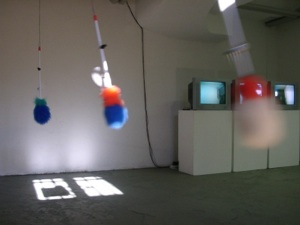
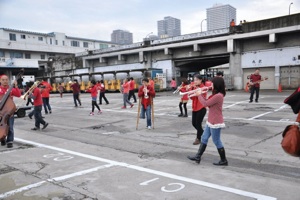
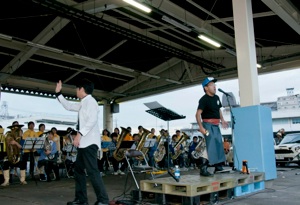
NUo
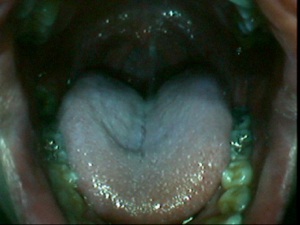
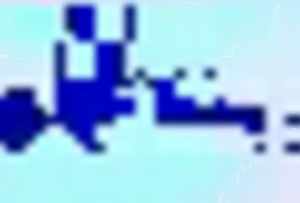
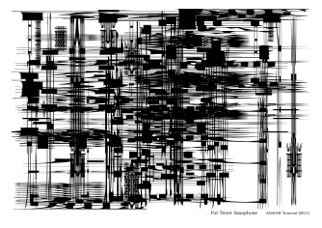
Video / Visual Work / Visual Poetry
Originally I used a live video camera to emphasize visual elements of my sound performance. Also see sel-made instrument page for my video synthesizer. My visual works are transformations from time-based musical ideas into static visible forms. Mainly I applied traditional musical forms to visual materials. Some of them were made as attached works for art theory bulletin "Method" 2000-2001.
Compositions for Voices
Though I regard even original interfaces and self-made instruments as a kind of compositions/notation form, a large part (more than 30 pieces) of my conventional compositions (written on papers) is for a voice ensemble without precise pitch, with meaningless phonemes. In the other words, they are sound poetry for an ensemble. These are investigations for how collective performance can be organized without traditional musical technics. I had my own choir group “Adachi Tomomi Royal Chorus” for my own composition and some of other composer’s during 1997-2002. After breaking up the group, I have presented several days workshops with musicians and non-musicians and performed my piece with them in many countries.
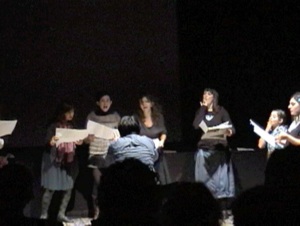
Compositions for Instrument / Ensemble
Works for ensembles, conventional instruments or robot notated by video, graphic, chart, text and traditional western notation.
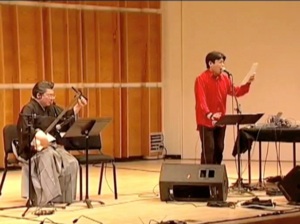
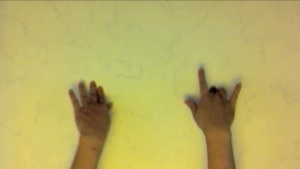
Odorinbisha (2007) TOKIWAZU Mojibei V (shamisen, voice), ADACHI Tomomi (electronics, voice)
Still from video score “Why you scratch me, not slap?”
Youtube
Single channel video. It is a kind of a recording of my voice performance without editing except the very last part. I regarded a video camera as an allegory of microphone in this video. In the last part, the mouth can be an allegory of a camera shutter. My interest in that part is an exchange between objectivity and subjectivity
Links
Chinese Character for Instrument (2011)
(Graphic score / Visual poem / Text score) not direct link, see 2011.
This is a series of graphic scores/visual poems/text scores.
All elements of scores consist of zoomed, reversed and/or superimposed Chinese characters (Mincho-tai font) which only express the instrumentation as their titles describe. If the tile is "For Piano," the word "Piano" is translated in Chinese Characters, only the characters are used in the score. They must include our understandings about the instrumentation/instrument visually because Chinese character is ideogram.
Though there are no instructions for musical performances because these scores are autonomous works and self-referential instructions on themselves, musical interpretations are encouraged.
These pieces are intermedia among graphic score, visual poetry and text score, the method of visual poetry connects the idea of graphic score with text score.
The Theme of “pig with mic,” 10 variations and 5 enlargements (2001)
This work deals with the concept of theme and variation in music. Also the concept is related to serialism and counterpoint. These series of digital images was made by unusual transformation of digital data. The image at the upper left is original theme (it is a fragment of another work) The digital data of this image was operated as text data. By using a text editor, one letter of the data was transposed to another letter in a systematic way. These processes were perfectly mathematical but consequential images are unforeseen. These processes generated the images on the first horizontal row. The images on the vertical lines were enlargements of a part of images on the upper row. The enlargement process was intuitive.
4 movements for 1 player and some instruments (2003)
This series is a sculptur-ize of the concept of harmony and the musical performance. In this exhibition, each movement had 5 hours duration without any changes and "movement”. It needed 4 days to perform all movements.
Etude for 6 instruments (2001)
Sequence of harmonies.